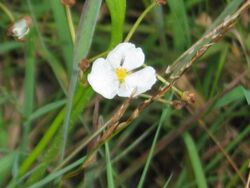Biology:Sagittaria graminea
| Grass-leaved arrowhead | |
|---|---|

| |
| Scientific classification | |
| Kingdom: | Plantae |
| Clade: | Tracheophytes |
| Clade: | Angiosperms |
| Clade: | Monocots |
| Order: | Alismatales |
| Family: | Alismataceae |
| Genus: | Sagittaria |
| Species: | S. graminea
|
| Binomial name | |
| Sagittaria graminea | |
| Synonyms[1] | |
| |
Sagittaria graminea, the grassy arrowhead[2] or grass-leaved arrowhead,[3] is an aquatic plant species native to eastern North America.
Description
It is a perennial herb up to 100 centimetres (39 inches) tall with narrow, grass-like leaves about 20 cm (8 in) in length and 2.5 cm (1 in) wide.[4][5][6] A very thin flower-bearing stalk raises to about 60 cm (24 in) above water. The flowers are about 1.5 cm (5⁄8 in) wide, with three petals and three sepals; typically the upper flowers only have stamens (male), while lower flowers have only pistils (female).[6] The seeds appear in a head about 1.5 cm wide.[6]
Subspecies
A long list of varietal and subspecific names have been proposed over the years. Most have either been elevated to the species level or relegated to synonymy. As of April 2014, only two are recognized:[1][7]
- Sagittaria graminea subsp. graminea
- Sagittaria graminea subsp. weatherbiana (Fernald) R.R.Haynes & Hellq.[8]
Distribution and habitat
The species is known from every Canada province from Ontario to Newfoundland, and every US state from the Great Plains to the Atlantic, plus Colorado, New Mexico and Cuba. It is considered naturalized in Washington state and in Vietnam.[7][4] It grows in wet areas such as marshes and the banks of rivers and lakes.[6]
References
- ↑ 1.0 1.1 The Plant List, Sagittaria graminea
- ↑ "Sagittaria graminea". Natural Resources Conservation Service PLANTS Database. USDA. https://plants.usda.gov/core/profile?symbol=SAGR. Retrieved 26 October 2015.
- ↑ (xls) BSBI List 2007, Botanical Society of Britain and Ireland, https://bsbi.org/download/3542/, retrieved 2014-10-17
- ↑ 4.0 4.1 "Sagittaria graminea in Flora of North America @ efloras.org". http://www.efloras.org/florataxon.aspx?flora_id=1&taxon_id=222000336.
- ↑ André Michaux. 1803. Flora Boreali-Americana 2: 190, Sagittaria graminea.
- ↑ 6.0 6.1 6.2 6.3 Spellenberg, Richard (2001). National Audubon Society Field Guide to North American Wildflowers: Western Region (rev ed.). Knopf. pp. 334. ISBN 978-0-375-40233-3. https://archive.org/details/nationalaudubons00spel/page/334/.
- ↑ 7.0 7.1 "World Checklist of Selected Plant Families: Royal Botanic Gardens, Kew" (in en-GB). http://apps.kew.org/wcsp/namedetail.do?name_id=287261.
- ↑ Garden., Missouri Botanical (1996-01-01). "Novon" (in en). Novon: A Journal for Botanical Nomenclature (Missouri Botanical Garden) v. 6 1996. ISSN 1055-3177. https://www.biodiversitylibrary.org/page/662095#page/368/mode/1up.
External links
- Missouri Botanical Garden, Plant Finder, Gardening Help, Sagittaria graminea
- Plants for a Future
- Lady Bird Johnson Wildflower Center, University of Texas
- Center for Aquatic and Invasive Plants, University of Florida IFAS
Wikidata ☰ Q15601416 entry
 |

